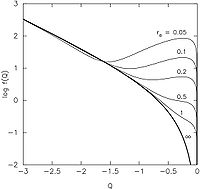
Osipkov-Merritt model
Encyclopedia

Distribution function
In molecular kinetic theory in physics, a particle's distribution function is a function of seven variables, f, which gives the number of particles per unit volume in phase space. It is the number of particles per unit volume having approximately the velocity near the place and time...
s that reproduce a specified density profile (representing stars) in a specified gravitational potential (in which the stars move). The density and potential need not be self-consistently related.
A free parameter adjusts the degree of velocity anisotropy, from isotropic to completely radial motions. The method is a generalization of Eddington's formula for constructing isotropic spherical models.
The method was derived independently by its two eponymous discoverers. The latter derivation includes two additional families of models (Type IIa, b) with tangentially anisotropic motions.
Derivation
According to Jeans's theorem, the phase-space density of stars must be expressible in terms of the isolating integrals of motion, which in a spherical stellar system are the energy
must be expressible in terms of the isolating integrals of motion, which in a spherical stellar system are the energyEnergy
In physics, energy is an indirectly observed quantity. It is often understood as the ability a physical system has to do work on other physical systems...
 and the angular momentum
and the angular momentumAngular momentum
In physics, angular momentum, moment of momentum, or rotational momentum is a conserved vector quantity that can be used to describe the overall state of a physical system...
 . The Osipkov-Merritt ansatz
. The Osipkov-Merritt ansatzAnsatz
Ansatz is a German noun with several meanings in the English language.It is widely encountered in physics and mathematics literature.Since ansatz is a noun, in German texts the initial a of this word is always capitalised.-Definition:...
is

where
 , the "anisotropy radius", is a free parameter. This ansatz implies that
, the "anisotropy radius", is a free parameter. This ansatz implies that  is constant on spheroids in velocity space since
is constant on spheroids in velocity space since
where
 are velocity components parallel and perpendicular to the radius vector
are velocity components parallel and perpendicular to the radius vector  and
and  is the gravitational potential.
is the gravitational potential.The density
 is the integral over velocities of
is the integral over velocities of  :
:
which can be written

or

This equation has the form of an Abel integral equation and can be inverted to give
 in terms of
in terms of  :
:
Properties
Following a derivation similar to the one above, the velocity dispersions in an Osipkov-Merritt model satisfy
The motions are nearly radial (
 ) for
) for  and nearly isotropic (
and nearly isotropic ( ) for
) for  . This is a desirable feature, since stellar systems that form via gravitational collapse
. This is a desirable feature, since stellar systems that form via gravitational collapseGravitational collapse
Gravitational collapse is the inward fall of a body due to the influence of its own gravity. In any stable body, this gravitational force is counterbalanced by the internal pressure of the body, in the opposite direction to the force of gravity...
have isotropic cores and radially-anisotropic envelopes.
If
 is assigned too small a value,
is assigned too small a value,  may be negative for some
may be negative for some  . This is a consequence of the fact that spherical mass models can not always be reproduced by purely radial orbits. Since the number of stars on an orbit can not be negative, values of
. This is a consequence of the fact that spherical mass models can not always be reproduced by purely radial orbits. Since the number of stars on an orbit can not be negative, values of  that generate negative
that generate negative  's are unphysical. This result can be used to constrain the maximum degree of anisotropy of spherical galaxy models.
's are unphysical. This result can be used to constrain the maximum degree of anisotropy of spherical galaxy models.In his 1985 paper, Merritt defined two additional families of models ("Type II") that have isotropic cores and tangentially anisotropic envelopes. Both families assume
 .
.In Type IIa models, the orbits become completely circular at
 and remain so at all larger radii.
and remain so at all larger radii.In Type IIb models, stars beyond
 move on orbits of various eccentricities, although the motion is always biased toward circular. In both families, the tangential velocity dispersion undergoes a jump as
move on orbits of various eccentricities, although the motion is always biased toward circular. In both families, the tangential velocity dispersion undergoes a jump as  increases past
increases past  .
.Carollo et al. (1995) derive many observable properties of Type I Osipkov-Merritt models.
Applications
Typical applications of Osipkov-Merritt models include:-- modelling of star cluster
Star cluster
Star clusters or star clouds are groups of stars. Two types of star clusters can be distinguished: globular clusters are tight groups of hundreds of thousands of very old stars which are gravitationally bound, while open clusters, more loosely clustered groups of stars, generally contain less than...
s, galaxies, dark matter halo
Dark matter halo
A dark matter halo is a hypothetical component of a galaxy, which extends beyond the edge of the visible galaxy and dominates the total mass. Since they consist of dark matter, halos cannot be observed directly, but their existence is inferred through their effects on the motions of stars and gas...
s and galaxy cluster
Galaxy cluster
A galaxy cluster is a compact cluster of galaxies. Basic difference between a galaxy group and a galaxy cluster is that there are many more galaxies in a cluster than in a group. Also, galaxies in a cluster are more compact and have higher velocity dispersion. One of the key features of cluster is...
s;
-- constructing anisotropic galaxy models for studies of dynamical instabilities.

